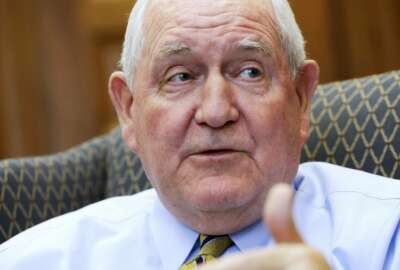USDA will loosen its telework policy, consider new remote work options
The Agriculture Department's new telework policy will fall more closely in line with the program Secretary Tom Vilsack established when he first led USDA in 2014.
The Agriculture Department is considering several changes to its pre-pandemic telework policy, including a broader array of new remote work policies, remote duty stations and other flexible schedule options.
USDA Secretary Tom Vilsack announced his intentions to develop a new telework and remote work policy during a town hall with employees last week.
A USDA spokesman confirmed the comments to Federal News Network.
A formal policy is still in the works, and employees said they haven’t received any written guidance that explains the details.
But Vilsack has asked his staff to begin replacing the department’s 2018 policy, which limited employees to one day of telework a week, with something more in line with the program he started back in 2014 during his time as USDA secretary in the Obama administration.
Under the previous 2014 policy, USDA employees could telework up to four days a week.
“This is our starting point,” the department’s spokesman said. “We will be taking a more holistic approach toward strategic flexibilities across the board. We will also be seeking input from our union partners, employees and supervisors, stakeholders and congressional leaders about the new approach. Telework can save federal dollars and make USDA a great place to work.”
Former USDA Secretary Sonny Perdue changed the department’s telework policy back in 2018, and the decision was met with criticism from employees, who saw the previous program as a model in the federal government.
After USDA limited telework in 2018, many other agencies followed suit, including the Social Security Administration and Education Department.
But that all changed last spring, when the pandemic forced nearly every agency to expand the number of employees who are authorized to telework. “Maximum telework” policies have largely been in place for many agencies for much of the last year.
The experiences of the last year have sparked conversations within individual agencies about the future of telework once the pandemic ends. Some agencies see full-time, permanent telework arrangements as a way to hire top talent from anywhere in the country without requiring them to move within commuting distance of the office.
USDA is having those conversations as well, and they seem to be part of the plan the department is developing.
“USDA will embrace workplace flexibilities, to include increased telework, expanded use of virtual and remote duty stations and enhanced work schedule flexibilities,” the spokesman said. “This will allow us to recruit and retain the absolute best talent, which will make USDA an employer of choice. This will be one of our highest management priorities.”
Federal employee unions said USDA seems to be moving in a positive direction.
“That all sounds great, and the union would be happy to work with them on that,” said David Verardo, president of American Federation of Government Employees local 3403, which represents workers at USDA’s Economic Research Service and National Institute of Food and Agriculture, as well as the National Science Foundation and National Endowment for the Arts.
Tony Reardon, national president of the National Treasury Employees Union, said he spoke to Vilsack about issues important to the USDA workforce, and telework was a priority for both of them. NTEU represents a small number of employees at the Food and Nutrition Service and the Farm Service Agency.
“USDA employees have proven during the pandemic that telework is the safest way to protect employees and maintain productivity, and we look forward to working with Secretary Vilsack on expanding telework opportunities even when the pandemic subsides,” Reardon said. “Flexible work options such as telework are a smart way to improve morale and boost recruitment and retention by offering family-friendly policies that recognize the changing American workplace.”
For Verardo, the direction USDA is moving in is indicative of conversations that other agencies are having.
He said the National Science Foundation is discussing a hybrid workforce concept, where some employees work on site and others work remotely from geographically dispersed locations. Telework would remain an option for those employees who work on site and live within commuting distance of an NSF facility.
“We’re basically brainstorming,” Verardo said. “What are the pros and cons… what do we want to do? How does this affect our mission? If [remote work] diminishes our mission, then we won’t do it. But it would be a transformative move.”
Offering more flexible remote work policies could be especially helpful for USDA subcomponents that have lost large portions of their workforces in recent years and are struggling to rebuild.
Both ERS and NIFA lost 40-to-60% of their workforces during a 2019 relocation to Kansas City, and both bureaus still have at least 100 vacancies each.
“There are some people who moved to Kansas City and will want to stay there; they uprooted their lives,” Verardo said. “We’d like to consult with the secretary about having a kind of mixed workforce, with some people working remotely and some in D.C. and Kansas City. A hybrid system is something I think he would consider.”
More flexible work policies could be enough to attract some former ERS and NIFA employees, who left the agency because of the Kansas City relocation, to return, Verardo said.
It could also allow USDA to hire more people from the communities they serve, a stated goal of the previous administration’s Kansas City move.
“It was the wrong execution of the right idea,” Verardo said of the relocation. “If you really do want to move people out of D.C. and save rent, why pick a particular location? Why not allow people to live where they want to live, and also be closer to the people they serve?”
Copyright © 2025 Federal News Network. All rights reserved. This website is not intended for users located within the European Economic Area.
Nicole Ogrysko is a reporter for Federal News Network focusing on the federal workforce and federal pay and benefits.
Follow @nogryskoWFED
Related Stories





